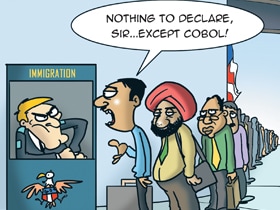
It Makes the World Go Round
This big daddy of business software gave Indian code-writers their first big break
France’s social security system runs on it. State Bank of India’s customer records and Life Insurance Corporation’s policy database depend on it. India’s booming software industry was originally built with expertise in it. A small applause then, suits as well as nerds, for COBOL as it turns 50.
Few inventions can rival COBOL, or Common Business Oriented Language, in its longevity and resilience. COBOL is to today’s computer languages what Latin or Sanskrit would be to English or Hindi. But unlike those ancient languages, COBOL is still robust. Hardly any other computer technology developed during the baby boom generation is as relevant today.
“COBOL has lasted that long because one, a lot of mission-critical stuff was written on it and two, because it is a rigorous and solid language,” says Drake Coker, who has two decades of working on COBOL behind him. Coker, chief scientist at Microfocus, a business software company, created the best-selling COBOL compiler AcuCobol-85. He says the language is so versatile that it has been upgraded continuously and it can compete any day with modern programming languages.
COBOL has doubtless come a long way since the 1950s when a computer scientist named Grace Hopper figured that programs could be written in a high-level language resembling English rather than obscure machine code. This notion pretty much led to the development of COBOL by Hopper and her colleagues.
It is also the language that those massive beasts called mainframes understand. Infosys had a great understanding of IBM AS/400, Big Blue’s best-selling product line of the late 1980s. Almost 80 percent of the work of Infosys and Tata Consultancy Services in those days came to them because of their flair for COBOL.
So when the world was on the brink of the Y2K apocalypse in 1999, Indian companies were happy to rescue it. Since COBOL had been used to write 80 percent of the world’s business applications, Indian companies got shiploads of Y2K “correction” work. And that was a game-changer for the industry. And even today, those skills come in handy because many critical business applications still run on COBOL.
To many, COBOL appears to be verbose and bureaucratic. Unlike modern languages like C++ and Java, COBOL does not allow sudden off-the-cuff modifications inside the program. Everything must be thought of in advance in COBOL.
Also, it is hard to get young programmers get interested in writing applications that shuffle around data when they can write fancy mobile applications or cool network management programs. Coker has a solution. “We have upgraded it significantly and have many features that languages like C++ have. We are also trying to make sure that programs written in it integrate with programs written for the Web,” he says.
Such upgrades and a deluge of data that companies now collect imply that COBOL is still bashing on regardless. Even three years ago, a Computerworld survey found that 62 percent of survey respondents ran COBOL applications in their machines. Most of them said they will continue to write new COBOL based applications.
(This story appears in the 30 November, -0001 issue of Forbes India. To visit our Archives, click here.)





